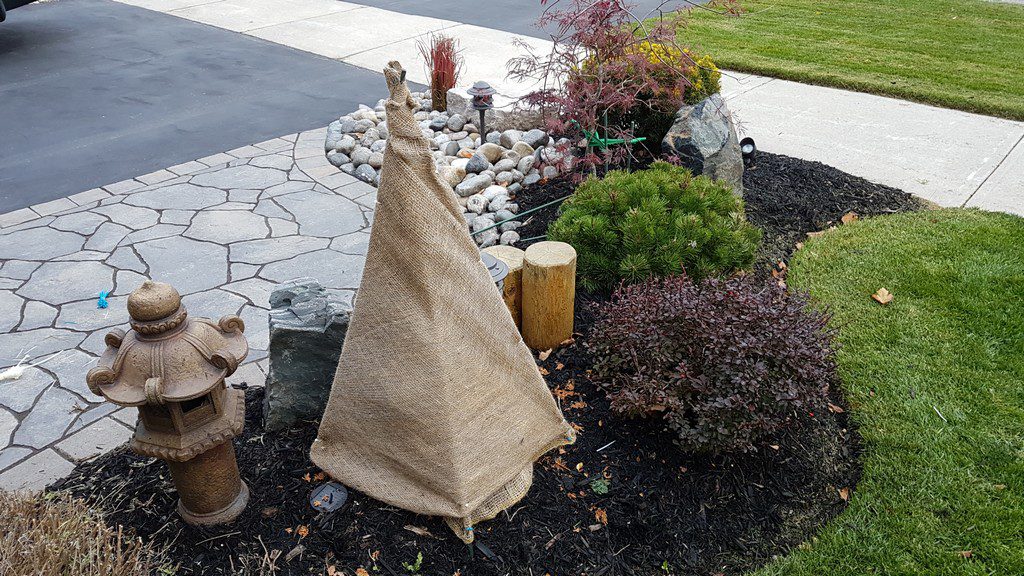- September 26, 2024
- Posted by: wellcoindustries
- Categories: Burlap, Erosion Control
As winter approaches, gardeners know how crucial it is to protect their plants from the harsh elements. From frost to freezing winds, winter conditions can be unforgiving to even the hardiest of plants. Fortunately, there’s a simple and natural solution that can help safeguard your garden – burlap. In this complete guide, we’ll walk you through the steps of how to use burlap to cover plants for winter, ensuring your plants remain healthy and strong throughout the colder months.

Why Protect Plants in Winter?
Winter can be a challenging season for your garden, especially for delicate plants like shrubs, perennials, and evergreens. Cold winds, frost, and heavy snow can damage plants by freezing their tissues, causing dehydration, or breaking branches. For these reasons, it’s essential to give your plants the protection they need.
While there are several ways to protect plants during winter, burlap stands out as a cost-effective, eco-friendly, and breathable material that offers excellent protection without trapping excess moisture. Let’s explore why burlap is such an ideal choice for plant protection.
What is Burlap and Why Use It?
Burlap is a coarse, woven fabric made from natural fibers, most commonly jute or hemp. It’s known for its breathability and durability, making it a popular choice for protecting plants during winter. But why choose burlap over other materials like plastic or cloth?
- Breathability: Unlike plastic, which can trap moisture and lead to rot or mildew, burlap allows air to circulate, reducing the risk of plant damage.
- Eco-friendliness: Burlap is biodegradable and a sustainable option for environmentally-conscious gardeners.
- Durability: Burlap can withstand strong winds and harsh conditions without tearing easily.
By using burlap to cover your plants, you provide them with a natural barrier against winter’s worst elements, while still allowing them to breathe and avoid moisture buildup.
Step-by-Step Guide: How to Use Burlap to Cover Plants for Winter
Now that you know the benefits of burlap, let’s dive into the step-by-step process of using it to protect your plants during the colder months.
Step 1: Choose the Right Burlap
Not all burlap is created equal. When choosing burlap for winter plant protection, opt for tightly woven burlap that is sturdy enough to withstand winter weather. You can find burlap rolls at most garden centers or online retailers. Make sure the burlap is untreated and free of chemicals, as you want to use a natural material for plant safety.
Step 2: Prepare the Plants
Before you start covering your plants, it’s important to prepare them. Begin by pruning any dead or damaged branches, which will help prevent further injury during the winter. You should also clean away fallen leaves, debris, or pests that could harbor diseases or pests over the winter.
For more delicate plants, consider applying a layer of mulch around the base to provide additional insulation. This extra step helps keep the soil warmer and prevents the roots from freezing.
Step 3: Construct a Burlap Frame
While it may be tempting to drape burlap directly over your plants, this can lead to damage if the fabric becomes too heavy with snow or ice. Instead, create a simple burlap frame.
To do this, use wooden stakes or a wire frame to build a structure around the plant. Make sure the frame is tall and wide enough to cover the plant without touching the leaves or branches. This frame will support the burlap, ensuring the weight of snow or ice doesn’t damage the plant.
Step 4: Wrapping or Draping Burlap Over Plants
Once the frame is in place, drape the burlap over the top, ensuring it covers the entire plant from the ground up. If you prefer, you can wrap the burlap around the frame like a cocoon, but leave some space between the plant and the fabric for airflow. This helps prevent condensation and moisture buildup.
Make sure the burlap extends to the ground to protect the roots and base of the plant from frost.
Step 5: Securing the Burlap
Finally, you’ll need to secure the burlap so it doesn’t blow away in strong winds. Use twine, zip ties, or garden clips to fasten the burlap to the stakes or frame. For added security, you can weigh down the edges of the burlap with rocks or bricks.
Check the burlap periodically throughout the winter to ensure it remains in place and is providing adequate protection.
Additional Tips for Burlap Plant Protection
- How long to leave burlap on: Burlap should stay on your plants for as long as freezing temperatures persist. Once the risk of frost has passed in early spring, remove the burlap to allow your plants to enjoy sunlight and fresh air.
- Regular checks: Check your burlap covering periodically for damage or loose sections, especially after a storm.
- Other uses for burlap: Aside from winter plant protection, burlap can also be used as a garden mulch, weed barrier, or even as a windbreak for more delicate garden areas.
Conclusion
Burlap is a simple yet effective solution for winter plant protection. Its natural properties provide a breathable, durable, and eco-friendly barrier that helps protect your plants from winter’s harshest elements. By following the steps outlined in this guide, you can ensure your plants are well-prepared to withstand the cold and emerge healthy and strong in the spring.
Start using burlap in your garden this winter, and see the difference it makes. Share your experiences with winter gardening and burlap plant covers, and let us know how your plants fare in the coming seasons!
